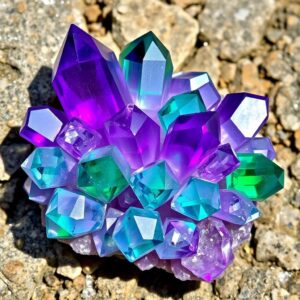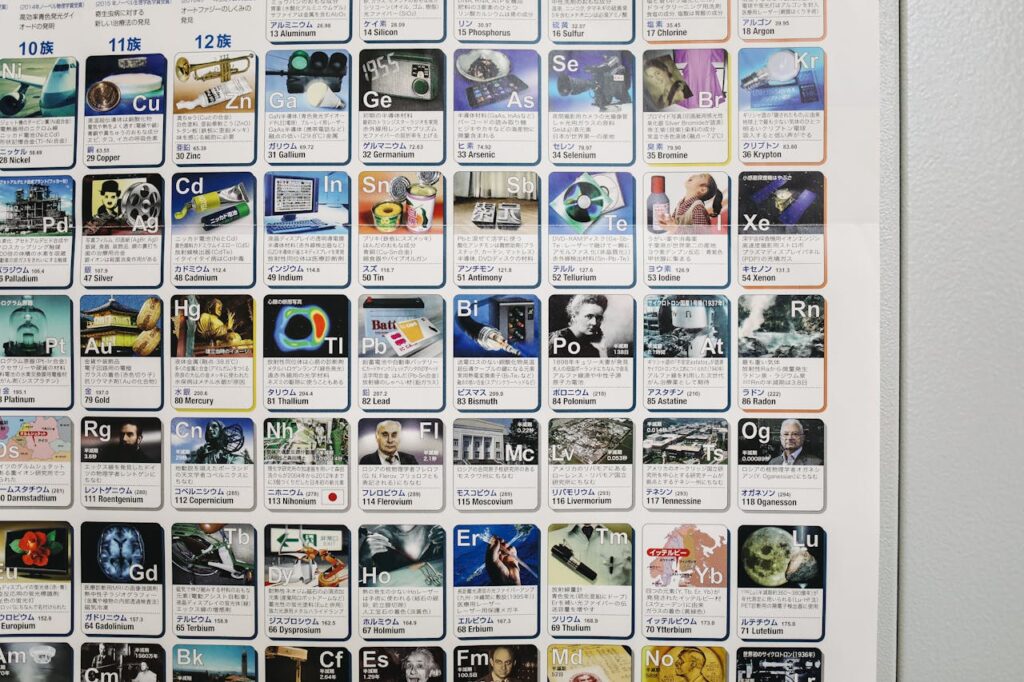
Explore & Play
Discover interesting topics and solve the accompanying crossword puzzle.
Element Crossword | Discover Elements in Daily Life
Table of Contents
Welcome to our exploration of the elements that make up our world! To kick things off, we invite you to try our “Element crossword” challenge. This engaging puzzle will test your knowledge and help you spot various elements featured in this article. If you’re new to the topic or want a deeper understanding of how these elements impact our daily lives, feel free to start by reading the article. Once you’re familiar with the concepts, come back and see how many clues you can solve in the crossword. Enjoy the journey through the world of elements!
Element Crossword
You can either fill in the crossword puzzle directly on this page or click the button in the bottom right corner to print it for free.

Elements in Everyday Life: Surprising Ways They're Used Around You
Every day, we interact with countless elements from the periodic table, often without even realizing it. From the air we breathe to the technology we use, elements play vital roles in nearly every aspect of our lives. Understanding these elements not only broadens our knowledge of chemistry but also opens our eyes to the wonders of the world around us. Before diving in, why not try our “Element Crossword Challenge” to see how many you can identify from your daily surroundings?
1. The Air We Breathe: Gases that Keep Us Alive
The very air we breathe is a complex mixture of elements, each playing a crucial role in maintaining life on Earth.
Oxygen is essential for life, supporting the process of respiration in humans and animals and enabling combustion. When you light a candle or breathe deeply after a workout, oxygen is at work. Meanwhile, Nitrogen makes up about 78% of our atmosphere. Though it doesn’t support respiration directly, it is vital for plant growth. Nitrogen is a key component of chlorophyll, which plants use for photosynthesis.
We also encounter Carbon in our everyday lives, often in the form of carbon dioxide, a gas that plants absorb to release oxygen. Carbon is the backbone of all known life; it’s found in carbohydrates, fats, and proteins that make up our bodies. Even trace elements like Helium and Neon have unique uses: Helium fills balloons because it is lighter than air, and Neon is used in bright, glowing signs that light up our cities.
2. Water and Beyond: Elements in Liquids
Even the water we drink is more than just H₂O; it carries a variety of elements that impact our health and environment.
Hydrogen, a component of water, is the most abundant element in the universe. It’s not only crucial for creating water molecules but also a potential future energy source. When hydrogen is used in fuel cells, it combines with oxygen to produce electricity, with water vapor as the only emission.
Chlorine, on the other hand, is known for its role in keeping our water supplies safe. It disinfects drinking water and is widely used in swimming pools to kill bacteria. Beyond our taps, Bromine is another element found in liquids. Derived from seawater, bromine is often used in flame retardants and in the development of certain medications, showcasing its versatility and value.
3. Metals at Home: From Kitchen to Garden
From cooking utensils to the nails in our walls, metals are a staple in every household.
Aluminum is perhaps one of the most ubiquitous metals in our kitchens, found in foil, soda cans, and many cooking utensils. Lightweight and resistant to corrosion, aluminum is ideal for storing food. Similarly, Copper is a household essential, largely due to its excellent electrical conductivity, making it perfect for wiring and plumbing systems. When you switch on a light or turn on the tap, copper is silently doing its job.
Iron is another common metal, used in everything from cast iron pans to structural components in our homes. It provides strength and durability, while Zinc serves as a protective coating to prevent rust, especially in garden tools and outdoor furniture. Meanwhile, Tin is frequently used to coat other metals and create alloys like bronze. You might be surprised to learn that the shiny, protective layer on some cans is actually made from tin!
4. Essential Elements in Food and Health
Our bodies depend on a range of elements to function properly, from the calcium in our bones to the iron in our blood.
Calcium is well-known for building strong bones and teeth. We get this essential element from dairy products like milk and cheese, as well as green leafy vegetables. Iron plays a vital role in transporting oxygen throughout the body, and a deficiency can lead to anemia, causing fatigue and weakness. Iron-rich foods include red meats, beans, and spinach.
Equally important are Sodium and Potassium, which help regulate nerve signals and muscle contractions. Found in common table salt, sodium is also present in many processed foods, while potassium is abundant in bananas, oranges, and potatoes. Magnesium, often found in nuts and seeds, is crucial for muscle function and helps maintain healthy nerve activity.
5. Elements Powering Modern Technology
From smartphones to satellites, elements are the backbone of modern technology.
Silicon is the star of the show in modern electronics. As the primary component in semiconductors, it makes computers, smartphones, and countless other devices possible. Lithium powers our digital lives through its use in rechargeable batteries, essential for laptops, smartphones, and electric vehicles.
Elements like Gallium are key to energy-efficient lighting, appearing in LEDs and photovoltaic cells used in solar panels. Nickel and Cobalt also play crucial roles in battery production, while Copper, Silver, and Gold are revered for their exceptional electrical conductivity, making them indispensable in circuitry and connections.
6. Elements in Everyday Cleaning and Cosmetics
Our cleaning supplies and beauty products often contain elements that enhance their effectiveness.
Sodium is not just in our food; it’s also a key ingredient in many soaps and detergents. Sodium compounds help soaps dissolve in water, improving their ability to clean surfaces. Fluorine is most familiar in the form of fluoride, added to toothpaste to strengthen tooth enamel and prevent cavities.
Meanwhile, Sulfur is found in certain acne treatments and shampoos for dandruff. This element has natural antibacterial properties that help treat skin conditions, demonstrating its importance in personal care.
7. Rare and Precious: Unique Uses of Less Common Elements
Some elements may not be as well-known, but they have unique applications that make them invaluable.
Titanium is a marvel in the medical world, used for implants due to its strength and biocompatibility. You’ll also find it in high-performance sports equipment and even in aerospace engineering. Rhodium and Palladium are often used in catalytic converters to reduce harmful emissions from vehicles, while their shiny appearance also makes them popular in jewelry.
Scandium is another rare element, primarily used in aerospace components to create lightweight, strong materials. Technetium might be less familiar, but it is essential in the field of nuclear medicine, used in imaging scans to help diagnose conditions. Meanwhile, Yttrium and Zirconium find their place in LED displays and nuclear reactors, showing that even less common elements have critical roles.
8. Elements That Light Up Our World: Noble Gases
Noble gases might be rare, but they play a bright role in our everyday lives.
Neon is best known for its vibrant, glowing signs that add character to cities worldwide. These signs work because neon gas emits a bright red-orange light when electrified. Argon, another noble gas, is used in light bulbs to prevent the tungsten filament from corroding. It is also crucial in welding, providing an inert atmosphere to shield welds from oxidation.
Then there’s Krypton, which is utilized in flash photography to produce bright white light. These gases, though less common, illuminate our world in more ways than one.
9. Future of Elements: Innovations and Sustainability
As we look to the future, the elements around us are being used in new ways to address global challenges.
Molybdenum and Niobium are becoming increasingly important in sustainable energy technologies, such as wind turbines and advanced batteries. Meanwhile, Cadmium and Indium are critical components in solar panels, helping to convert sunlight into electricity.
Boron is essential in developing lightweight, high-strength materials, and Phosphorus remains crucial for agriculture as a key component in fertilizers. Together, these elements are helping us build a more sustainable world, finding innovative uses that protect our planet.
Conclusion: Discover the Elements Around You
From the air we breathe to the technology we rely on, elements are the foundation of our everyday experiences. The periodic table may seem like a list of obscure symbols, but in reality, each element plays a role in our daily lives, shaping our environment, health, and technology. Now that you have a deeper understanding of the elements around you, revisit our “Element Crossword Challenge” to see how many you can identify with your newfound knowledge!
Share to...
I hope you enjoy the content.
Want to receive our daily crossword puzzle or article? Subscribe!
You may also be interested in
Share to…
Want to receive our daily crossword puzzle?
-
Jigsaw Puzzles
Vigeland Park Fantasy Puzzle 250 | 300 | 500 Pieces
kr 348,00 – kr 439,00Price range: kr 348,00 through kr 439,00 Select options This product has multiple variants. The options may be chosen on the product page -
Jigsaw Puzzles
Blue-Eyed Kitten Puzzle Delight 250 | 300 | 500 Pieces
kr 348,00 – kr 439,00Price range: kr 348,00 through kr 439,00 Select options This product has multiple variants. The options may be chosen on the product page -
Jigsaw Puzzles
Majestic Horse Watercolor Jigsaw Puzzle 250 | 300 | 500 Pieces
kr 348,00 – kr 439,00Price range: kr 348,00 through kr 439,00 Select options This product has multiple variants. The options may be chosen on the product page

















